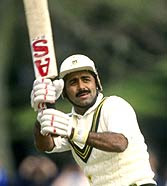
Australia rode an unbeaten century from captain Michael Clarke to hand Pakistan an eight-wicket defeat and secure the five match one-day series with a match to spare.
Clarke scored a fluent 100 off 122 deliveries while Shane Watson supported him with 85 not out, the two helping Australia easily overhaul Pakistan's measly total of 197 all out, after they had batted first.
Doug Bollinger had wrecked Pakistan's line-up with an accurate spell which earned him five wickets for 35 runs in only his second one-dayer, but Shoaib Akhtar threatened to better that effort when he sent back both openers cheaply, reducing Australia to three for two.
But Clarke and Watson weathered the storm and lifted Australia out of a slump with an unbroken third-wicket stand worth 197 as Australia finished at 200 for two in 44.2 overs.
Shoaib dismissed Brad Haddin for a golden duck and ended debutant Marcus North's innings early by trapping him in front for one.
Shoaib should have had the wicket of Watson immediately thereafter, but his appeal for leg before was turned down by umpire Aleem Dar.
Sohail Tanvir, Akhtar's new ball partner, kept the pressure on with a maiden first up, but Clarke and Watson slowly wrested control.
Younus shuffled his bowlers around and even brought on Shahid Afridi inside the powerplay in an effort to break the partnership, but the Australian duo remained watchful and resolute.
Afridi's match ended at the start of the 36th over when he came on to bowl, but pulled up with a strained calf muscle even before he could deliver. He hobbled off the field, with three overs of his quota remaining.
Clarke brought up his fourth one-day century with a cracking cover drive off Shoaib, while Watson finished off the chase by sweeping Seed Ajmal for a boundary.
Earlier Afridi made a run-a-ball 40 and opener Ahmed Shehzad top scored with a patient 43, but Pakistan's innings stuttered and stumbled and eventually ended in 48.4 overs.
Bollinger, who was handed the new ball, secured his first one-day international wicket when he dismissed the dangerous Salman Butt (two) off just the third delivery of the innings.
Then Younus, who got off the mark with an inside-edged boundary that narrowly missed leg stump, made seven before he was accounted for by Nathan Bracken, the left-arm seamer pegging back leg stump via an inside edge.
Bracken should have had the wicket of Misbah-ul-Haq with his next ball, the Pakistan vice-captain edging to Haddin, but umpire Dar ruled not out.
Misbah struggled against the spinners and looked scratchy right through, but he rode his luck and added 68 for the third wicket with Shehzad.
Misbah's laboured innings finally ended on 34 when he attempted to sweep Clarke, missed the ball completely and was trapped plumb in front.
Pakistan then lost wickets in quick succession as Shehzad holed out to long-on.
Shoaib Malik (27), who had shown positive intent, was trapped in front by Bollinger, the left-arm quick's second wicket and Kamran Akmal managed just one run before he was bowled by Stuart Clark.
Afridi, in typically brisk fashion, knocked the bowlers around, all the while getting Pakistan closer to the 200-run mark.
He had hammered Clark for a couple boundaries in the seamer's sixth over, but mistimed a pull while attempting to force the pace in the batting powerplay and presented Bollinger with his third wicket.
Yasir Arafat chipped in with a useful, unbeaten 23, but Bollinger ran through the tail, claiming the wickets of Shoaib and Saeed Ajmal in his eighth over as Pakistan's innings ended prematurely.
The fifth match of the series is on Sunday.
















































